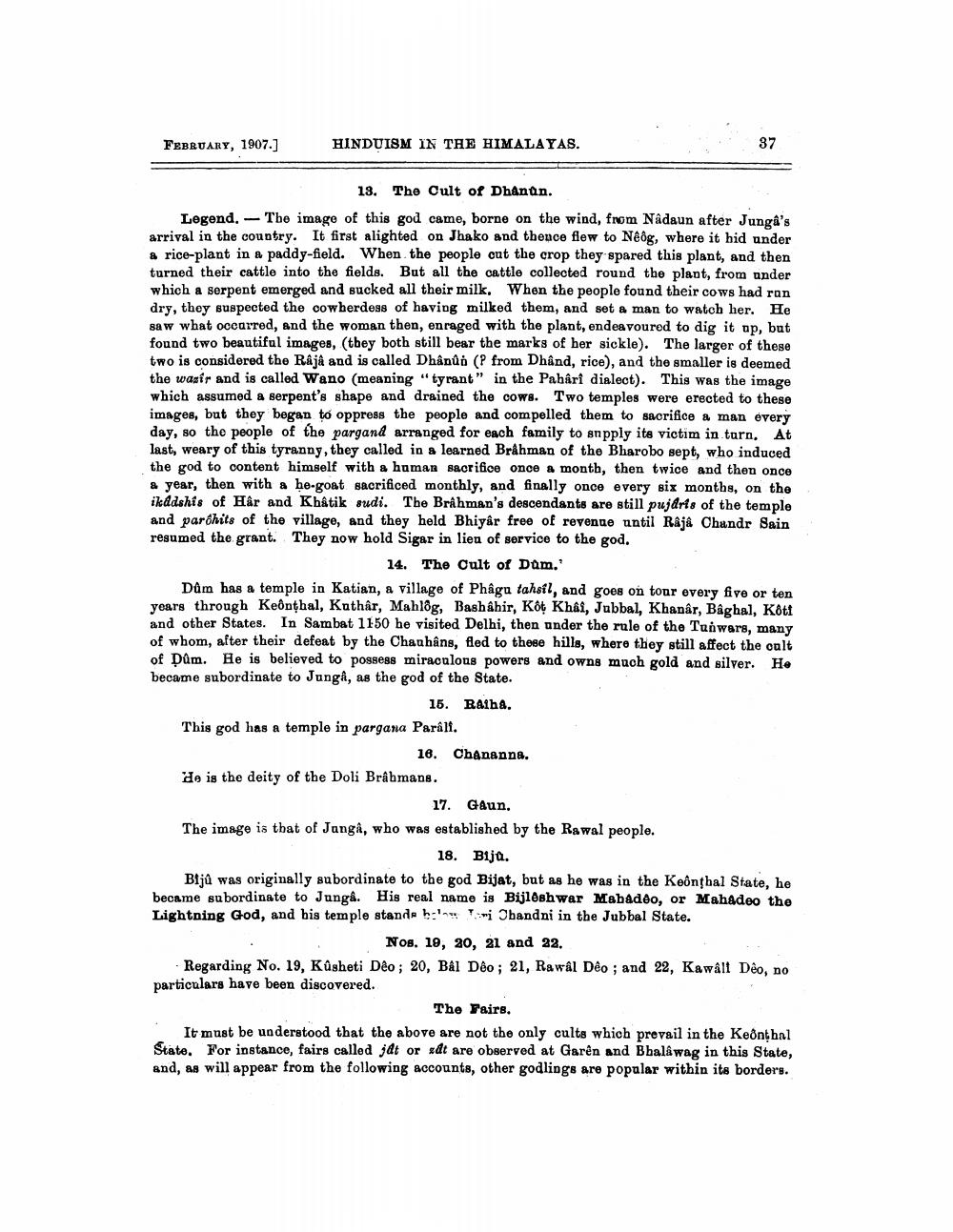________________
FEBRUARY, 1907.]
HINDUISM IN THE HIMALAYAS.
37
13. The Cult of Dhanan. Legend, -The image of this god came, borne on the wind, from Nadaun after Junga's arrival in the country. It first alighted on Jhako and thence flew to Néog, where it hid under a rice-plant in a paddy-field. When the people cut the crop they spared this plant, and then turned their cattle into the fields. But all the cattle collected round the plant, from under which a serpent emerged and sucked all their milk. When the people found their cows had ran dry, they suspected the cowherdess of having milked them, and set a man to watch her. He saw what occurred, and the woman then, enraged with the plant, endeavoured to dig it op, but found two beautiful images, (they both still bear the marks of her sickle). The larger of these two is considered the Rają and is called Dhânúi (P from Dhånd, rice), and the smaller is deemed the wasir and is called Wano (meaning " tyrant" in the Pahârî dialect). This was the image which assumed a serpent's shape and drained the cows. Two temples were erected to these images, but they began to oppress the people and compelled them to sacrifice a man every day, so the people of the pargand arranged for each family to snpply ite victim in turn. At last, weary of this tyranny, they called in a learned Bråhman of the Bharobo sept, who induced the god to content himself with a human sacrifice once a month, then twice and then once & year, then with a he-goat sacrificed monthly, and finally once every six months, on the ikddshis of Hâr and Khâtik sudi. The Brahman's descendants are still pujdris of the temple and paröhits of the village, and they held Bhiyâr free of revenue until Raja Chundr Sain resumed the grant. They now hold Sigar in lieu of service to the god.
14. The Cult of Dum. Dům has a temple in Katian, a village of Phâgu tahsil, and goes on tour every five or ten years through Keônthal, Kuthâr, Mahløg, Bashahir, Kót Khai, Jubbal, Khanar, Baghal, Kött and other States. In Sambat 1150 he visited Delhi, then under the rule of the Tunwars, many of whom, after their defeat by the Chauhậns, fled to these hills, where they still affect the calt of Dum. He is believed to possess miraculous powers and owns much gold and silver. He became subordinate to Jungå, as the god of the State.
15. Raiha. This god has a temple in pargana Parali.
16. Chananna. de is the deity of the Doli Brâhmans.
17. Gaun. The image is that of Janga, who was established by the Rawal people.
18. Bija. Bijů was originally subordinate to the god Bijat, but as he was in the Keônthal State, he became subordinate to Junga. His real name is Bijleshwar Mabadeo, or Mahadeo the Lightning God, and his temple stande h: Tri Obandni in the Jubbal State.
Nos, 19, 20, 21 and 22. Regarding No. 19, Kusheti Deo; 20, Bal Deo; 21, Rawal Deo ; and 22, Kawalt Deo, no particulars have been discovered.
The Fairs. It must be understood that the above are not the only cults which prevail in the Keðnthal State. For instance, fairs called jdt or udt are observed at Garên and Bhalawag in this state, and, as will appear from the following accounts, other godlings are popular within its borders.




